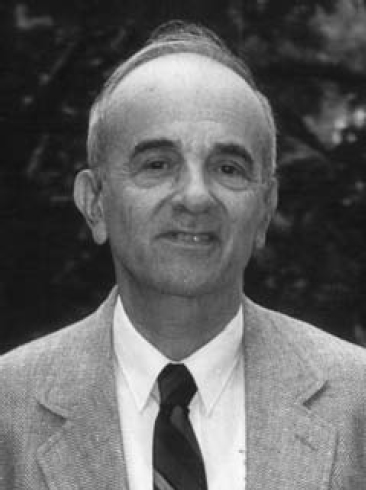FERDINAND FREUDENSTEIN

1926–2006
Elected in 1979
“For leadership and research in kinematics and design of mechanisms.”
BY BERNARD ROTH
SUBMITTED BY THE NAE HOME SECRETARY
FERDINAND FREUDENSTEIN, longtime Columbia University mechanical engineering professor who is considered the father of modern kinematics in America, died on March 30, 2006, at the age of 79.
Ferdinand Freudenstein was born into a Jewish family, on May 12, 1926, in Frankfurt am Main, Germany. When Ferdinand was 10 years old, he, his parents, and two sisters fled the Nazis for safety in Holland. In the spring of 1937, after six months in Amsterdam, the family moved to England, where they joined his brother, who was studying there. They lived in London during the Blitz, moved briefly to Cambridge, and then spent several years in Llandudno, North Wales. During this period his father and brother, were sent into exile in Australia, since the British government regarded all adult male German citizens, even victims of Nazi anti-Semitism, as enemy aliens.
In 1942, when he was 16 years old, Ferdinand, his mother, and one sister sailed on an old British cargo boat from England to Trinidad. They remained there for six weeks until a distant cousin arranged for their visas to the United States. They arrived in New York harbor in March 1942. Ferdinand had a high school equivalency certificate from Wales and was able to enter college at New York University. He spent two years studying there and then at age 18 joined the U.S. Army.He was able to graduate from the Army Specialized Training Program in Engineering, at Texas A&M (1945). After the Army, he went to Harvard University and earned an M.S. degree in mechanical engineering (1948). He then worked, for approximately two years, as a development engineer in the Instrument Division of the American Optical Company in Buffalo, New York, before he left to study for his Ph.D. at Columbia University. This work experience helped solidify a strong youthful fascination with machines. His longtime interest was further stimulated by subsequent summer jobs as a development engineer at Ford Instrument and American Machine and Foundry and as a member of the technical staff at Bell Laboratories.
At Columbia University he encountered a major obstacle: No one on the faculty did research in kinematics of mechanisms. Fortunately, Professor H. Dean Baker, a specialist in combustion, agreed to be Freudenstein’s thesis supervisor and to allow him to work on mechanism kinematics, even though Baker himself knew very little about the subject. For the rest of his life, Ferdinand was extremely grateful for what he considered an act of great kindness and generosity on Baker’s part.
After Ferdinand received his Ph.D., he was appointed to an assistant professorship in Columbia University’s mechanical engineering department. His career up the academic ladder was meteoric. In less than three years he was promoted to associate professor. Then one year later he became the chairman of the Department of Mechanical Engineering, a post he held for six years. After only two years as an associate professor, he was promoted to the rank of professor (1959).
In the same year, at the age of 33, he married Leah Schwartzchild. Their first child, David, was born on February 3, 1961, and their second child, Joan, was born on February 6, 1964. The young family took up residence in the Riverdale section of the Bronx, where they purchased a comfortable three-story brick house on a quiet residential street. Ferdinand lived in that house for the rest of his life.
As a researcher, he had made his mark early with his seminal Ph.D. dissertation in which he developed what is known as Freudenstein’s equation. At the end of the 1950s and the beginning of the 1960s, Ferdinand’s kinematics program at Columbia started to get worldwide recognition. It became known as the best place to study mechanism kinematics in the United States. He attracted prominent colleagues from abroad, some of whom he collaborated with on research projects. During a long career at Columbia University, he and his students produced outstanding research results in most areas of modern kinematics. At the time of his death there were over 500 academic descendents belonging to the Freudenstein family tree.
In the midst of all Ferdinand’s professional success, tragedy struck when his wife Leah died in May 1970. This created a huge challenge for Ferdinand who had not had any real experience with domestic details, such as cooking and running a household. Fortunately, he was a quick learner. For the next 10 years, he ran the household and was both mother and father to his children. At the same time he remained a highly productive and world-renowned Columbia professor.
In May 1980, 10 years after the death of his first wife, Ferdinand married Lydia Gersten. Lydia was a teacher who was widowed, had grown children, and was caring for her elderly mother. Lydia and her mother moved into the house in Riverdale. Lydia took over the domestic management of the household and became a close and loving partner in Ferdinand’s life. Over the next years, Ferdinand’s children grew up, Lydia’s mother died, and Lydia and Ferdinand became the sole occupants of the house. Their marriage flourished for nearly 26 years, until Ferdinand’s death, and was the great gift in the last half of his life.
Two years after he remarried, Ferdinand was made Stevens Professor of Mechanical Engineering. He held this chair for two years and then in 1985 was made Higgins Professor, a position he held until his retirement. In addition to these honors, he was elected a member of the National Academy of Engineering, an honorary member of International Federation for the Promotion of Mechanism and Machine Science, and a fellow of the New York Academy of Sciences; he also became an honorary life fellow of the American Society of Mechanical Engineers. He accumulated a long list of other awards for his research and teaching.
Throughout his career Ferdinand was also as an industrial consultant. He very much valued these contacts and the insights they afforded into “real-world” engineering problems. His main consulting activities were with Bell Telephone Laboratories, Designatronics, IBM, The Singer Company, Foster Wheeler, Gulf and Western, and General Motors. The General Motors consulting activities went on for over 15 years.
An interesting event occurred at an American Society of Mechanical Engineers meeting in San Francisco in 1972, where Freudenstein was the scheduled luncheon speaker. At one point, as part of the introduction, the moderator asked that “all the people in the room who are either part of the Freudenstein academic family tree or feel that their work has been strongly influenced by their relation with him please rise from your seats.” At that moment, almost all of the approximately 200 people in the room rose to their feet. Similar requests were made subsequently at other meetings over the years, and the results were the same. It always created a powerful emotional response to witness this physical demonstration of Freudenstein’s great influence on the field.
Ferdinand Freudenstein was a kind and soft-spoken individual. He was extremely modest. He was an accessible professor and was always pleased to assist his professional colleagues at Columbia and throughout the world. His benevolent influence was felt, both directly and indirectly, by practically everyone who taught or did research in the field of kinematics or machines and mechanisms. His progeny are teachers in many different countries, and his research results have shaped the teaching and practice of mechanism and machine theory throughout the world. In addition, his descendants have taken his basic ideas into new areas of interest, such as mechatronics (particularly robotics), microelectromechanical systems, biochemistry,
and bioengineering, where they have also made pioneering contributions.
The warm memories for him as well as his strong influence on the field will be with us long into the future. Ferdinand is survived by his wife, Lydia; his son, David; his daughter, Joan; three grandchildren; two sisters, Elsa and Greta; and by now almost 600 academic descendants.
His wife Lydia Freudenstein wrote:
“It was my great good fortune to meet and marry Ferdinand Freudenstein. As he is described in his professional life, so he was in his personal life: kind, gentle, modest, and thoughtful. He had a subtle sense of humor which was evident at special family gatherings when he would write spoofs and poetry relating to the occasion. His piano playing also added to the enjoyment at these times.
Ferdinand always seemed in equilibrium, never angry or anxious. His work and his thoughts protected him from the trivial problems that one encounters in daily life.
Ferdinand enriched the work with his seminal contributions to the science of mechanisms; but he also enriched his many colleagues and students with friendship, and his family with love.”
Please refer to : https://www.nap.edu/read/13160/chapter/18#97



